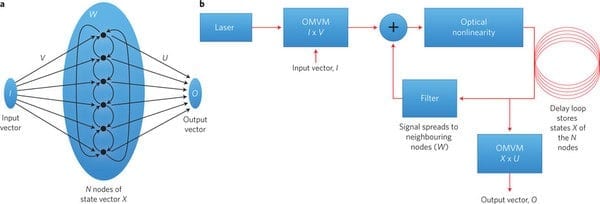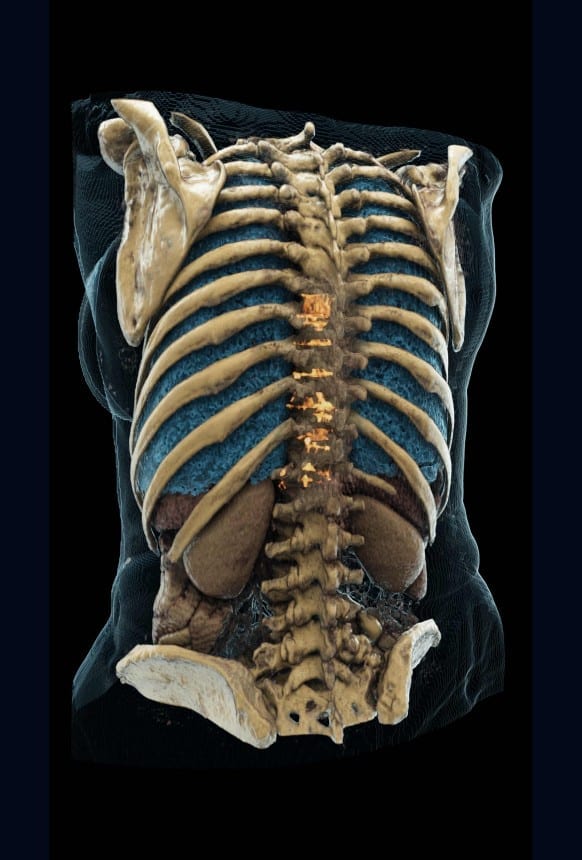
Neural networks using light could lead to superfast computing.
Neural networks are taking the world of computing by storm. Researchers have used them to create machines that are learning a huge range of skills that had previously been the unique preserve of humans—object recognition, face recognition, natural language processing, machine translation. All these skills, and more, are now becoming routine for machines.
So there is great interest in creating more capable neural networks that can push the boundaries of artificial intelligence even further. The focus of this work is in creating circuits that operate more like neurons, so-called neuromorphic chips. But how to make these circuits significantly faster?
Today, we get an answer of sorts thanks to the work of Alexander Tait and pals at Princeton University in New Jersey. These guys have built the world’s first photonic neuromorphic chip and show that it computes at ultrafast speeds.
Optical computing has long been the great white hope of computer science. Photons have significantly more bandwidth than electrons and so can process more data more quickly. But the advantages of optical data processing systems have never outweighed the additional cost of making them, and so they have never been widely adopted.
That has started to change in some areas of computing, such as analog signal processing, which requires the kind of ultrafast data processing that only photonic chips can provide.
Now neural networks are opening up a new opportunity for photonics. “Photonic neural networks leveraging silicon photonic platforms could access new regimes of ultrafast information processing for radio, control, and scientific computing,” say Tait and co.
At the heart of the challenge is to produce an optical device in which each node has the same response characteristics as a neuron. The nodes take the form of tiny circular waveguides carved into a silicon substrate in which light can circulate. When released this light then modulates the output of a laser working at threshold, a regime in which small changes in the incoming light have a dramatic impact on the laser’s output.
Crucially, each node in the system works with a specific wavelength of light—a technique known as wave division multiplexing. The light from all the nodes can be summed by total power detection before being fed into the laser. And the laser output is fed back into the nodes to create a feedback circuit with a non-linear character.
An important question is just how closely this non-linearity mimics neural behavior. Tait and co measure the output and show that it is mathematically equivalent to a device known as a continuous-time recurrent neural network. “This result suggests that programming tools for CTRNNs could be applied to larger silicon photonic neural networks,” they say.
That’s an important result because it means the device that Tait and co have made can immediately exploit the vast range of programming nous that has been gathered for these kinds of neural networks.
They go on to demonstrate how this can be done using a network consisting of 49 photonic nodes. They use this photonic neural network to solve the mathematical problem of emulating a certain kind of differential equation and compare it to an ordinary central processing unit.
The results show just how fast photonic neural nets can be. “The effective hardware acceleration factor of the photonic neural network is estimated to be 1,960 × in this task,” say Tait and co. That’s a speed up of three orders of magnitude.
That opens the doors to an entirely new industry that could bring optical computing into the mainstream for the first time. “Silicon photonic neural networks could represent first forays into a broader class of silicon photonic systems for scalable information processing,” say Taif and co.
Of course much depends on how well the first generation of electronic neuromorphic chips perform. Photonic neural nets will have to offer significant advantages to be widely adopted and will therefore require much more detailed characterization. Clearly, there are interesting times ahead for photonics.
Learn more: World’s First Photonic Neural Network Unveiled
The Latest on: Photonic Neural Networks
[google_news title=”” keyword=”Photonic Neural Networks” num_posts=”10″ blurb_length=”0″ show_thumb=”left”]
via Google News
The Latest on: Photonic Neural Networks
- Taichi: A large-scale diffractive hybrid photonic AI chipleton April 16, 2024 at 6:20 am
A combined team of engineers from Tsinghua University and the Beijing National Research Center for Information Science and Technology, both in China, has developed a large-scale diffractive hybrid ...
- Photonic computation with sound waveson April 16, 2024 at 2:02 am
Also, on-chip implementations of optical neural networks can benefit from this approach, which is implementable in photonic waveguides without additional electronic controls. “Photonic machine ...
- Using sound waves for photonic machine learning: Study lays foundation for reconfigurable neuromorphic building blockson April 16, 2024 at 2:00 am
Optical neural networks may provide the high-speed and large-capacity solution necessary to tackle challenging computing tasks. However, tapping their full potential will require further advances. One ...
- Photonic computation with sound waveson April 15, 2024 at 5:00 pm
“I’m very excited that we have embarked on this new line of research pioneering the use of sound waves to control optical neural networks. Our research findings have the potential to spark the ...
- A New Photonic Computer Chip Uses Light to Slash AI Energy Costson April 15, 2024 at 1:45 pm
The chip was nearly 92 percent accurate at image recognition, matching current chip performance, but cut energy consumption over a thousand-fold.
- NTT Research unveils AI model, sustainable path for AI, and better distributed data centerson April 11, 2024 at 3:00 pm
Japanese telecommuications firm NTT announced a series of research projects that could pave the way for better AI and more energy efficient data centers.
- NTT Open To ‘Embryonic Exploration’ Of Photonics Software Developmenton April 11, 2024 at 11:04 am
We know that almost every longstanding software platform tool, operating system or application goes through a series of logical incremental progressions and ...
- Photonic neuromorphic architecture for tens-of-task lifelong learningon April 6, 2024 at 5:00 pm
The photonic connections in each optical layer ... constraints of electronics-based implementations of artificial neural networks (ANNs). Photonic computing has been promised to overcome the ...
- Research team develops reconfigurable photonic computing architecture for lifelong learningon April 3, 2024 at 8:28 am
The community is seeking next-generation computing modalities to break through the physical constraints of electronics-based implementations of artificial neural networks (ANNs). Photonic ...
via Bing News










